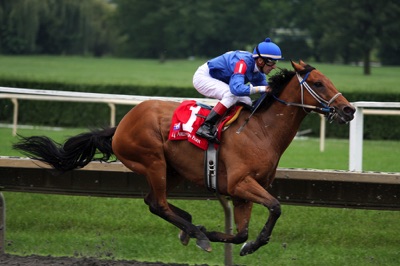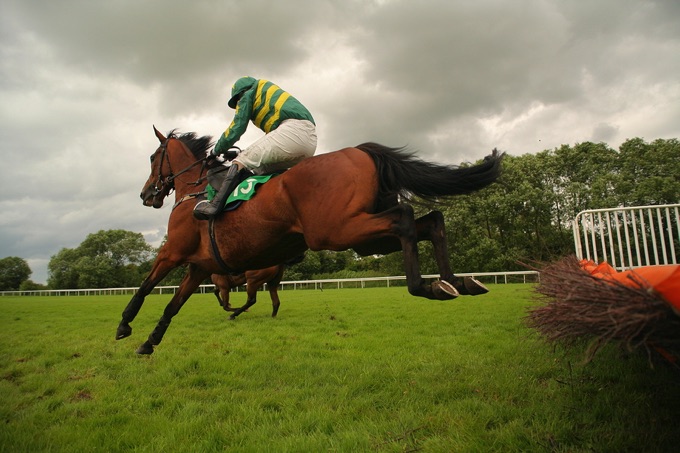 If you’ve watched a reasonable amount of horse racing but don’t even begin to consider yourself an aficionado then you might well have noticed that races are given different grades and put into groups, but you might not have given it much thought. After all, what difference does it make what grade a particular race is? Will it change your bet if you know that you’re watching a Group 1 race rather than one of the other types?
If you’ve watched a reasonable amount of horse racing but don’t even begin to consider yourself an aficionado then you might well have noticed that races are given different grades and put into groups, but you might not have given it much thought. After all, what difference does it make what grade a particular race is? Will it change your bet if you know that you’re watching a Group 1 race rather than one of the other types?
In all honesty, the answer to that is probably ‘no’. Even so, there are enough different types of race classification that you should learn a little bit about them, especially as there’s something of a difference between all the various race types. It’s also worth noting that the way that races are classified in the jump world is different from how they’re classified when it comes to flat racing, so it’s not a one-size-fits-all scenario. I’m a firm believer in giving yourself every possible advantage, so understanding the difference between them all is key to being a good bettor.
Jump To: Flat Racing | Jump Racing
Flat Racing Grades

Let’s start by having a look at the world of flat racing and the different ways that the races are broken up there. They are split up into various classes and then have different race types within each class. Here I’ll explain how they all work.
Class 1 Races
This is the top level of flat racing and has several different sub-groups. The first and most important of these is the Classics, which are the 1,000 Guineas, the 2,000, Guineas, the Oaks, the Derby and the St. Leger. Typically speaking, the horses will carry the same weight as each other, though some races will give fillies and mares a slight allowance.
Within Class 1, you’ll find Group 1, Group 2 and Group 3 races, as well as Listed offerings. These breakdown further, with Group 1 races having a minimum value of £200,000 in races for horses aged three and over and £150,000 for horses aged two and up. They are for horses with ratings of 115 and over.
Group 2 races have a minimum value of £90,000 for horses aged three and over and £65,000 for those aged two and up, whilst Group 3 offerings have minimum values of £60,000 and £40,000 for horses aged three and up and two and up respectively. These races have a minimum rating of 110.
Listed races work slightly differently and often include handicaps, which in the case of Class 1 need to be for horses rated between 96 and 100 and have minimum values of £37,000 for horses aged three and over and £25,500 for those aged two and up. The races here boast a minimum rating of 105.
Conditions & Handicaps
Speaking in general terms, flat racing tends to separate its races out in the handicap offerings and conditions races. When it comes to the latter, the category gets its name from the fact that the races have certain conditions that need to be met in order for them to take place. One of the chief conditions involves the weights that have to be carried by the horses according to the likes of their age, sex and experience.
If you’ve ever heard the phrase ‘weight-for-age’ when it comes to horse racing then this is what that is referring to. The older and more experience a horse competing in a race is the large the weight is that they’ll have to to carry. Whilst it bears similarities, it is a different classification of race to the handicaps that are also part of the the British Horseracing Authorities race types.
In handicaps, the weight that a horse carries is determined by the handicapper, whose job is to try to make sure that all of the horses are carrying enough weight to mean that, in a perfect world, they’d all cross the finish line at exactly the same moment. Each horse’s handicap tends to be dictated according to their official rating, which is given to them by the BHA after several races and is constantly updated.
Handicap weights include the weight of both the jockey riding the horse and the equipment being used, so any weight not made up by the jockey and his equipment will be made up with extra weight added, usually in the form of synthetic materials bulked up until the correct weight amount is reached.
Group Races
The current system of grading for Group races was introduced in 1971 and, although it has been tweaked and altered a number of times, it remains much the same as it was back then. It’s a system that is employed throughout Europe and the races are categorised by the European Pattern Committee. The system changed slightly in 2010 when the Class system came into play for flat racing and races were put into Classes from 1 to 7.
The Main Race Types
In the world of flat racing there are twelve race types, which are as follows:
| Race Type | Important Information |
|---|---|
| Handicap | The official handicapper will determined the weight carried by each horse based on a number of factors |
| Heritage Handicap | Price money for these important races tends to exceed £100,000 |
| Nursery Handicap | A race run with handicaps for horses aged 2 |
| Classified Stakes | These races require competitors to have won 3 times or more with at least 1 win |
| Conditions Stakes | The weight-for-age system comes into play here as it does for Group races |
| Novice Race | Open to 2 and 3-year-olds who have only won 2 or fewer races |
| Maiden | Horses can’t take part in these races if they’ve won a race before. They’re typically for 2 and 3-year-olds |
| Claimers | There’s a maximum weight limit in play here and horses can be bought when the race is over. If they’ve run with a lower weight than the maximum, however, then they’ll be sold for less |
| Sellers | The winner of the race is put up for sale |
| Auction | The competitors are sold via auction after the race |
| Amateur | The restriction here comes not for the horse but for the jockey, with only amateurs allowed to compete |
| Apprentice | Similar to the Amateur races but the restriction in place means that the jockeys have to be amateurs |
Jump Racing Grades

Whilst there’s unquestionably some crossover between the two disciplines, jump racing does work differently to flat racing. For starters, the Class system employed in the latter isn’t used for the former and is is replaced by Graded racing. The general principle remains the same, though, with horses getting a rating according to their ability and that rating dictating which race types they’re able to take part in.
A rule of thumb to bear in mind when looking at class ratings is to remember that the better races usually see high prize pots. The money for jump racing tends to be a little bit lower than the money in flat racing, but that is evened out by the fact that jump racing horses race for longer. Indeed, some horses begin life on the flat and then move to the world of jump racing as they age, meaning that they’re ability to win prize money lasts for longer and they can therefore win more in the end than their flat racing equivalents.
How the Horses Are Rated
Just as there are crossover between the different race classifications, so is there a similarity when it comes to how the horses are rated in the worlds of jump racing and flat racing. The handicapper looks at the races of all of theorises and decides whether the rating that they’ve been assigned is a fair one.
Horses with a rating in excess of 100 are considered to be amongst the best, with those rating 140 and over in the elite bracket. The biggest crossover with flat racing comes in the fact that horses can either race in handicap offerings or conditions races. In the latter, the sex and rating of the horse will dictate whether or not they’re allowed to take part in the race.
Graded Races
Jump racing is broken down into different groupings, with Graded races sitting at the top of that. There are three main Grades:
Grade 1
The top level of jump racing is Grade 1, which have a minimum prize pot of £100,000. These weight-for-age races have conditions applied to them on a race by race basis. Normally previous wins don’t matter and most Grade 1 races ask females to carry less weight than their male counterparts.
The two best examples of big races that fit into Grade 1 are the King George VI Chase, which is run at Kempton Park during the Winter Festival, and the Cheltenham Festival’s Gold Cup. The former was first run in 1937 and the latter has been in play since 1924.
Grade 2
Though the quality here is slightly lower, it would be a lie to suggest that these races are all that different to Grade 1 offerings. The biggest difference is that previous wins are considered in Grade 2 races, though most of them are still weight-for-age conditions offerings.
Good examples of Grade 2 races at the time of writing include the Cotswold Chase, the Classic Novices’ Hurdle and the Prestbury Juvenile Novices’ Hurdle, all of which are hosted by Cheltenham Racecourse.
Grade 3
The overwhelming majority of Grade 3 races are handicaps, meaning that there’s no conditions that need to be met and the weight requirements of each horse are dictated by the handicapper. There are some conditions Grade 3 races, of course, but they’re much less common than the handicaps.
The irony of the Grading system in horse racing is that not all of the most popular races are automatically Grade 1 offerings. Head to Cheltenham in March, for example, and you’ll discover that the much-loved Coral Cup falls into that bracket. Perhaps even more surprising is the fact that the Grand National is a Grade 3 race, showing why taking the Grade of any given race into account isn’t necessarily the most important thing to think about.
The Jump Racing Classes
Outside of the three Grades there are a number of other race types when it comes to the world of the National Hunt racing. The first is a Listed race, which is a group made up of races that don’t quite have the quality of a Graded race but also aren’t as unimportant as a generic handicap offering.
Since 2010 National Hunt racing has, like flat racing, found its races split into 6 classes regardless of the class, though, the equivalent race in flat racing will be worth more money because jump racing isn’t seen to be as prestigious. It is, though, far more exciting, which is what makes it such a popular discipline with punters.
Here’s a look at a selection of the different races within jump racing, telling you what Class they fit into and what the minimum purse is for each of them. It’s worth noting that some of the race types are found in more than one Class.
| Race Type | Class | Minimum Purse |
|---|---|---|
| Graded | 1 | £100,000 / £50,000 / £40,000 |
| Listed | 1 | £27,500 |
| Open Handicaps & Conditions | 2 | £22,5000 |
| 0-145+ Rated Handicaps | 2 | £22,500 |
| Novices’, Juvenile & Beginners’ | 2 | £22,500 |
| NH Flat Race | 2 | £22,500 |
| Juvenile, Novices’, Beginners’ & Maidens | 3 | £25,000 |
| Sellers and Claimers | 4 | £11,500 |
| 0-100 Handicaps | 5 | £7,000 |
| Maidens | 5 | £7,000 |
| Sellers & Claimers | 5 | £7,000 |
| National Hunt Flat Races | 6 | £3,800 |
| Hunters’ Steeple Chases | 6 | £1,500 |
That list is far from exhaustive but it gives you an idea of the sort of race types that come into play within the six different classes that are used in National Hunt races.
The National Hunt Race Types
Despite being the name given to the jump racing side of the horse racing industry, not all National Hunt races are jumps and even those that are work in a slightly different way. Here’s a look at the different race types that the classifications fit into:
- Steeplechases: Based on the old notion of running from the steeple of the church in one location to the steeple of the church in another, this race type would see horses have to jump over any number of different obstacles. They’re represented in the modern era by fences consisting of hedges and sometimes boasting water or ditches on either side
- Hurdles: This is the race type that most younger jump horses being life attempting, thanks to the top of the hurdle being far more flexible than steeplechase jumps. The hurdles still need to be at least three foot six inches in height, though
- Bumpers: Also known as National Hunt flat races, they are longer than the same sort of races run during the flat season and are a test of the horse’s stamina more than their speed. These races often have significantly lower prize pools but are a good place to start if you’re hoping to spot a talented horse whilst it’s still young
Why It Matters
The final thing worth mentioning, then, is why the classification of a horse race matters. Whether you’re betting on flat races of their jump racing equivalents, it’s worth passing at least a moment’s interest in the type of classification that the race has been assigned.
The key thing is to keep an eye on a horse’s class because you can then spot whether or not they’ve been entered into a race that is beneath them. If that’s the case then you’ll know that they might be worth a punt, given that it would be like a Premier League footballer starting for a League Two team, depending on the difference between their true class and the class that they’re in.
You’ll still need to think about why it’s been put in that class in the first place. Is it because they’ve been getting gradually better and should probably be in the class above, or is it because their career is on the wane and they’ve been struggling at the higher end? The answer to this will tell you whether they’re likely to run well or badly depending on how the field responds to their presence.
To continue the football metaphor here to explain what I’m talking about, imagine a League Two side that has been bought by a billionaire. They’ve pumped money into it, buying the best players and bringing in a top manager seeing the team rise up to the Championship. Meanwhile another club has been in the Premier League but it’s sold all of its best players and the manager was lucky not to be sacked the season before, seeing his side relegated to the second-tier.
If you were betting on a match between the two teams then you’d probably go for the team that has risen through the ranks because they’re in a better place than the one that has been relegated. Well, the same sort of thing is true with horses. Has one horse been at the top of its game, regularly entered into Grade 1 offerings but has been struggling to reach those heights for a time now and is more regularly competing in Grade 3 races? Has the other risen through the ranks and continued to show great promise?
The best way to have an idea about how the horses are doing and whether or not they’re in the right class of race is by keeping an eye on the race class that they’re entered into and note whether they did well or struggled. Do that kind of research and you’ll almost certainly give yourself the best chance of taking the fight to the bookies.
